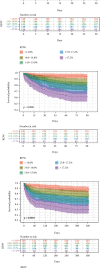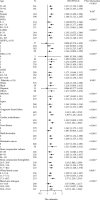A Retrospective Cohort Study on the Association between Red Cell Distribution Width and All-Cause Mortality of Patients with Cholecystitis at ICU Admission
- PMID: 34691290
- PMCID: PMC8528576
- DOI: 10.1155/2021/9625220
A Retrospective Cohort Study on the Association between Red Cell Distribution Width and All-Cause Mortality of Patients with Cholecystitis at ICU Admission
Abstract
Background: Elevated red cell distribution width (RDW) has been reported to be associated with mortality in some critically ill patient populations. The aim of this article is to investigate the relationship between RDW and in-hospital mortality and short- and long-term mortality of patients with cholecystitis.
Method: We conducted a retrospective cohort study in which data from all 702 patients extracted from the Medical Information Mart for Intensive Care III (MIMIC-III) database were used. Receiver operating characteristic (ROC) curves were constructed to evaluate the prognostic predictive value of RDW for in-hospital mortality and short- (i.e., 30-day and 90-day) and long-term (i.e., 180-day, 1-year, 3-year, and 5-year) mortality. We converted RDW into a categorical variable according to quintiles as less than or equal to 13.9%, 14.0-14.8%, 14.9-15.8%, and 15.9-17.2% and more than 17.2%. The Kaplan-Meier (K-M) methods and log-rank tests were used to compare survival differences among different groups. The relationships between RDW levels and in-hospital mortality were evaluated by univariate and multivariate binary logistic regression models. Multivariable Cox regression models were built to investigate the association of RDW on the short-term and long-term mortality.
Result: After adjusting for potential confounders, RDW was positively associated with in-hospital mortality (OR: 1.187, 95% CI [1.049, 1.343]) and short- (i.e., 30-day: HR: 1.183, 95% CI [1.080, 1.295], 90-day: HR: 1.175, 95% CI [1.089, 1.268]) and long-term (i.e., 1-year: HR:1.162, 95% CI [1.089, 1.240]) mortality in critically ill patients with cholecystitis. Similar results were also shown in the secondary outcomes of 180-day, 3-year, and 5-year mortality. RDW had a significant accurate prognostic effect on different endpoints and could improve the prognostic effect of scoring systems.
Conclusion: High level of RDW is associated with an increased risk of in-hospital mortality and short- and long-term mortality in critically ill patients with cholecystitis. RDW can independently predict the prognosis of patients with cholecystitis.
Copyright © 2021 Yihua Dong et al.
Conflict of interest statement
The authors declare that they have no conflicts of interest.
Figures




Similar articles
-
Red blood cell distribution width predicts long-term mortality in critically ill patients with acute kidney injury: a retrospective database study.Sci Rep. 2020 Mar 12;10(1):4563. doi: 10.1038/s41598-020-61516-y. Sci Rep. 2020. PMID: 32165684 Free PMC article.
-
Red Blood Cell Distribution Width as a Predictor of 28-Day Mortality in Critically Ill Patients With Alcohol Use Disorder.Alcohol Clin Exp Res. 2020 Dec;44(12):2555-2560. doi: 10.1111/acer.14483. Epub 2020 Nov 16. Alcohol Clin Exp Res. 2020. PMID: 33067833 Free PMC article.
-
Association Between the Red Blood Cell Distribution Width and 30-Day Mortality in Intensive Care Patients Undergoing Cardiac Surgery: A Retrospective Observational Study Based on the Medical Information Mart for Intensive Care-IV Database.Ann Lab Med. 2024 Sep 1;44(5):401-409. doi: 10.3343/alm.2023.0345. Epub 2024 Mar 12. Ann Lab Med. 2024. PMID: 38469636 Free PMC article.
-
The Association between Red Blood Cell Distribution Width and Mortality Risk after Hip Fracture: A Meta-Analysis.Medicina (Kaunas). 2024 Mar 14;60(3):485. doi: 10.3390/medicina60030485. Medicina (Kaunas). 2024. PMID: 38541211 Free PMC article. Review.
-
Red blood cell distribution width at admission and the short-term mortality of patients with severe burn injury: a meta-analysis.Eur J Med Res. 2024 Dec 18;29(1):589. doi: 10.1186/s40001-024-02165-z. Eur J Med Res. 2024. PMID: 39696510 Free PMC article.
Cited by
-
Modified Early Warning Score (MEWS) combined with biomarkers in predicting 7-day mortality in traumatic brain injury patients in the emergency department: a retrospective cohort study.PeerJ. 2025 Feb 13;13:e18936. doi: 10.7717/peerj.18936. eCollection 2025. PeerJ. 2025. PMID: 39959820 Free PMC article.
-
Association between Red Blood Cell Distribution Width and Short-Term Mortality in Patients with Paralytic Intestinal Obstruction: Retrospective Data Analysis Based on the MIMIC-III Database.Emerg Med Int. 2023 Oct 23;2023:6739136. doi: 10.1155/2023/6739136. eCollection 2023. Emerg Med Int. 2023. PMID: 37908808 Free PMC article.
References
-
- Sanders G., Kingsnorth A. N. Gallstones. BMJ . 2007;335(7614):295–299. doi: 10.1136/bmj.39267.452257.AD. - DOI - PMC - PubMed
MeSH terms
LinkOut - more resources
Full Text Sources

